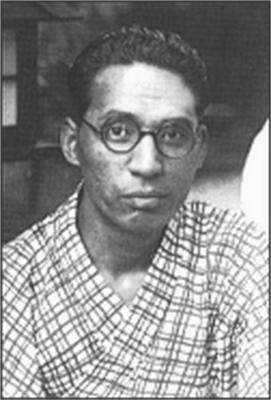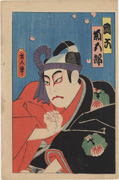Biographical Data
Throughout his artistic career designs for the Kabuki theater of scenery, programs and billboards were a primary source of income.
In 1930, his print Morning Hair 朝寝髪 (see below) was deemed "salacious" and banned by the censors, possibly based on their interpretation of the symbolism of the partially seen comb in the lower right. The woodblocks for the print were ordered destroyed and the remainder of copies confiscated, leaving around seventy prints in circulation. This event seems to have had no negative effect going forward for the artist.
last update:
Sources: The Female Image: 20th Century Prints of Japanese Beauties, Amy Riegle Newland and Hamanaka Shinji, Abe Publishing Ltd and Hotei Publishing, 2000, p. 212; Modern Japanese Woodblock Prints - The Early Years, Helen Merritt, University of Hawaii Press, 1998, p. 82; Modern Japanese Prints, Dorothy Blair, The Toledo Art Museum 1997; 近代日本版 画家名 (1900-1945) [Artist Names: Modern Japanese Printmakers], Hanga-do, Tokyo, p. 74; website of Utah Museum of Fine Arts "Seven Masters: 20th-Century Japanese Woodblock Prints" https://umfa.utah.edu/seven-masters; Ukiyo-e: The Art of the Japanese Print, Frederick Harris, Tuttle, 2010, p. 85 and as footnoted
 image source: | Torii Kotondo 鳥居言人 (1900-1976) A member of the venerable Torii school of artists, whose lineage goes back to the late 17th century printmaker and painter Torii Kiyonobu (1664-1729), he continued the school's tradition of designing prints of kabuki actors, creating advertisements and signboards for the kabuki theater. He also expanded his repertoire of work to designing bijin-ga (pictures of beautiful women), creating several masterworks. Born Saitō Akira 斎藤信1 on November 21, 1900 in the Nihonbashi district of Tokyo, his father sent him to study history and art at the age of fourteen under the tutelage of the yamato-e (traditional Japanese-style) painter Kobori Tomone 小堀鞆音 (1864-1931) known for his historic and military scenes who also designed kuchi-e for the popular magazine Bungei Kurabu.2 About a year after he began his studies with Kobori, he was adopted into Torii family as the son of Torii Kiyotada VII (1875-1941) and given the name Genjin 言人 (also pronounced Kotondo).3 At about the age of fifteen he was designing prints of kabuki actors carrying the signature Kotondo, both for the short-lived magazines Shin Nigao and the much longer-lived (1907-1943) magazine of the theater Engei gahō 演藝畫報. |
In 1918, at the age of eighteen, he was introduced by Kobori to the nihonga paintmaker and print designer Kaburaki Kiyokata (1878-1972) and became Kaburaki's student. (3) Kiyokata's influence on Kontodo's designs for bijin-ga can be seen along with that of shin hanga artists Goyō Hashiguchi's (1880-1921) and Itō Shinsui (1898-1972). His first known showing of bijin-ga occured in 1925 when several of his paintings were exhibited at the prestigious annual Inten exhibition. He would go on to design over twenty woodblock prints of bijin-ga, starting in 1929 and continuing until approximately 1935, for the publishers Sakai-Kawaguchi and Ikeda Tomizō. These prints were primarily marketed for sale in the United States4 and seventeen of his prints were included in the seminal 1936 exhibition of shin hanga at The Toledo Museum of Art.
Morning Hair 朝寝髪, 1930
publisher: Ikeda Tomizō
image source: Museum of Fine Arts, Boston 49.729
click on image to enlarge
Noh actor as Okina Sanbaso
performing Suzu no dan, undated
ink on silk
image source: Hotei Japanese Prints
Reports differ on when Kotondo took the name Torii VIII 八代目 鳥居, becoming leader of the Torii school, some saying it was not until after Torii VII's death in 1941, other sources claiming that he succeeded to that name in 1929 upon his father's retirement. Starting in 1937 he used the art name Kiyonobu 清言 working on stage designs for the Imperial Theater and other venues which was continue after the war. In 1962 he took the name Kiyotada V.
Kotondo would go on to teach theatrical art classes at Nihon University from 1966 until 1972 and work as an art critic. It is reported that in 1970 "he again assumed responsibility for painting signboards for the Torii school."He passed away on July 13, 1976 from cancer and in that same year was awarded the Order of the Sacred Treasure, Fifth Class 戦前は帝劇章.
1 The National Diet Library gives the pronunciation of his honmyō (real name) as Saitō Shin (サイトウ, シン) rather than Saitō Akira https://id.ndl.go.jp/auth/ndlna/00824930
2 also seen romanized as Tomoto.
3 sources differ as to whether he was the oldest natural son of Torii Kiyotada or his adopted son.4 Japanese Wood-block Prints, Shizuya Fujikake, Japan Travel Bureau, 1938, revised 1949 and 1953, p. 98.
last update:
8/5/2020 created



